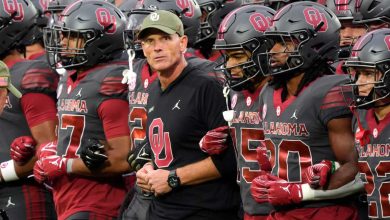In 2024, the Texas athletic department’s revenue and operational costs exceeded $300 million.

In 2024, the University of Texas Athletic Department achieved a significant financial milestone, surpassing $300 million in both revenue and operational costs. This achievement reflects not only the university’s strong performance in collegiate athletics but also its strategic investments, diversified revenue streams, and careful management of operational expenses. The 2024 fiscal year represents a critical juncture for the department, demonstrating how its financial success is intricately tied to the growth and expansion of the university’s athletic programs.
In this article, we’ll break down the key factors driving Texas’s financial success, analyze the revenue sources fueling this growth, examine the operational costs, and explore how these figures set the stage for the department’s future goals and ambitions. Additionally, we will look at how the department’s financial health is linked to broader trends in collegiate athletics, especially as the landscape of college sports continues to evolve.
Texas Athletics: A Legacy of Excellence
Before delving into the financial specifics of 2024, it’s important to understand the context in which the Texas Athletic Department operates. The University of Texas, located in Austin, is one of the most successful and prestigious athletic programs in the nation. Texas is home to multiple high-profile teams in football, basketball, baseball, and track and field, and its historical success in these sports has helped establish a massive fan base and unparalleled brand value.
The Texas Longhorns football team is perhaps the most prominent and lucrative program within the department. Texas football consistently ranks among the top programs in terms of attendance, merchandise sales, sponsorship deals, and television rights revenue. Historically, Longhorns football has been a powerhouse, and its prominence on the national stage attracts attention from fans, media, and corporate sponsors alike.
Other sports at Texas also contribute significantly to the department’s bottom line. The Texas men’s basketball team is frequently a top contender in the Big 12 Conference and has made numerous NCAA Tournament appearances. The women’s basketball program, led by coach Vic Schaefer, has gained recognition as a national powerhouse as well. Texas is also a force in baseball, with its success in the College World Series adding prestige and financial value to the athletic department.
Overall, Texas’s athletic department is a key revenue generator for the university, contributing not only to the school’s prestige but also providing substantial economic returns. The department’s ability to surpass the $300 million mark in 2024 highlights the growing financial strength of the program.
Revenue Streams Driving the $300 Million Milestone
1. Television and Media Rights
One of the most significant contributors to Texas Athletics’ revenue in 2024 is the substantial income generated from television and media rights. The explosion of media rights deals in recent years has reshaped the landscape of collegiate athletics, and Texas has been a primary beneficiary of these deals, particularly with the impending move to the Southeastern Conference (SEC).
For years, the Big 12 Conference provided Texas with a valuable media rights deal that generated significant income for the school. However, with the Longhorns set to join the SEC in 2025, the revenue potential from media rights deals will only increase. The SEC’s deal with networks like ESPN and CBS is one of the most lucrative in collegiate sports, expected to exceed $3 billion over the next decade. For Texas, this move is expected to lead to increased television exposure and even larger revenue shares, with the potential for more televised games and national coverage.
Beyond television deals, the department also generates revenue from streaming services, where exclusive content, games, and behind-the-scenes access are available through services like ESPN+. These new media channels continue to expand the department’s financial reach, making television and media rights one of the most significant pillars of Texas Athletics’ revenue structure.
2. Ticket Sales and Game Day Revenue
Ticket sales are a foundational revenue stream for any major collegiate athletic program, and Texas is no exception. The Darrell K Royal–Texas Memorial Stadium, the home of the Texas Longhorns football team, regularly fills to near-capacity, generating millions of dollars in ticket sales each season. Similarly, the Frank Erwin Center (soon to be replaced by the Moody Center) provides significant revenue for Texas basketball, and the UFCU Disch-Falk Field brings in crowds for Longhorns baseball games.
In addition to traditional ticket sales, game day revenues are boosted by premium seating, suites, and club seats, all of which command higher prices due to the prestige of the Longhorns’ programs. The revenue from these high-demand tickets is used to fund the athletic department’s operational costs and to reinvest in facility upgrades and player development.
Moreover, game day expenses such as staffing, security, and concessions contribute to operational costs, but the revenue generated from these elements often exceeds the costs, leading to substantial profitability for the department. With Texas’s commitment to maintaining world-class facilities and amenities for fans, game day revenue continues to be a vital source of financial support for the athletic department.
3. Sponsorships and Corporate Partnerships
Corporate sponsorships and partnerships are another major driver of revenue for Texas Athletics. The Texas Longhorns brand is one of the most recognizable in all of college sports, attracting partnerships with high-profile companies across various industries. These partnerships provide significant revenue in the form of sponsorship deals, advertising, and licensing agreements.
In 2024, Texas secured lucrative deals with major companies, ranging from automotive brands and technology firms to food and beverage companies. These sponsors often have their logos displayed prominently during televised games, on team uniforms, and throughout the stadium. In return, the sponsors receive national exposure, leveraging Texas’s fan base and visibility.
Additionally, the university’s long-term apparel deal with Nike and Bevo-branded merchandise sales contribute to the department’s financial stability. The Longhorns’ merchandise is highly sought after by fans, with jerseys, hats, and other gear consistently topping sales charts nationwide. This merchandising revenue not only serves as a significant income stream but also strengthens the connection between the university and its passionate fan base.
4. Alumni and Donor Contributions
The role of alumni donations and private contributions cannot be understated when examining the financial success of Texas Athletics. As one of the largest and most successful athletic departments in the country, Texas benefits from an expansive network of wealthy alumni who contribute generously to the athletic programs. The Texas Athletics Fund, which seeks donations for scholarships, facility improvements, and overall program support, receives millions of dollars in contributions each year.
In addition, Texas has benefited from major gifts for facility upgrades, including renovations to Texas Memorial Stadium and new facilities such as the Moody Center. These large donations are often made by high-profile individuals and corporate partners who view investing in Texas Athletics as a way to enhance the university’s reputation and legacy.
The $300 million revenue milestone in 2024 was partly driven by an uptick in donations from alumni and private donors eager to ensure the continued success of Texas’s athletic programs. As the university moves into the SEC, further donations are expected, driven by the excitement surrounding the conference shift and the increased competition.
Operational Costs: Balancing Revenue and Expenses
While revenue is a major focus, the operational costs required to maintain a program of Texas’s caliber are equally significant. Running a successful athletics department requires significant investment in various areas, from player development to facilities management. The $300 million in operational costs in 2024 reflects these expenses.
1. Coaching Salaries and Staff Compensation
One of the largest operational expenses for Texas Athletics is the cost of paying its coaches and support staff. The university has invested heavily in securing top-tier coaching talent, particularly in football and basketball. Head coaches like Steve Sarkisian (football) and Rodney Terry (basketball) command multi-million-dollar salaries, reflecting their experience and ability to lead premier programs.
In addition to head coaches, assistant coaches, trainers, analysts, and other support staff contribute to the operational expenses of the athletic department. This large staff is crucial for maintaining the quality of Texas’s programs and ensuring that players receive top-tier training, medical care, and academic support. As salaries for top coaches continue to rise, so too do the department’s payroll expenses.
2. Facility Maintenance and Upgrades
Another significant portion of operational costs goes toward maintaining and upgrading facilities. Texas Athletics takes great pride in its world-class facilities, including the Longhorn Foundation Performance Center, Texas Memorial Stadium, and the Moody Center. Keeping these facilities in top shape requires continuous investment in maintenance, upgrades, and the latest technology to enhance the fan experience and provide optimal conditions for athletes.
In addition, the construction of new facilities to accommodate growing sports programs or meet the demands of elite recruits often leads to substantial capital expenditures. For instance, the planned renovations and expansions to Texas Memorial Stadium to keep pace with other top-tier SEC facilities will require significant investment over the coming years.
3. Scholarships and Athlete Support
Providing scholarships for student-athletes is a core component of Texas’s operational costs. The university offers athletic scholarships to hundreds of student-athletes across various sports. These scholarships cover tuition, room and board, and other living expenses, which are a significant financial commitment for the athletic department.
Beyond scholarships, the department also invests in athlete support programs, including academic tutoring, mental health services, and career development initiatives. These investments ensure that athletes are well-rounded, successful both on and off the field, and prepared for life after college sports.
The Future of Texas Athletics: Maintaining Financial Success
As Texas Athletics continues to grow and evolve, maintaining financial health will be crucial to ensuring sustained success. The revenue generated by media deals, ticket sales, sponsorships, and donations will remain essential to the department’s operations, while operational costs will continue to rise as the program expands and competes at the highest level.
In particular, the transition to the SEC in 2025 promises to provide a wealth of new opportunities for Texas, both financially and competitively. With the potential for increased media exposure, higher-value sponsorships, and a deeper level of competition, Texas’s athletic department is poised to continue building on its $300 million success in the coming years.
Ultimately, the Texas Athletic Department’s financial success in 2024 is a testament to its continued dominance in collegiate athletics and its ability to strategically leverage resources. As the program moves forward, its financial prowess will be key in maintaining its status as one of the top athletic departments in the country.









